#northeastern american native plants
Text

Foam Flowers - Mt. Cuba, Delaware - May 6th 2023
#nature#forest#Delaware#mt cuba#foam flowers#northeastern american native plants#nature photography#original phography#spring
381 notes
·
View notes
Text
Virginia Bluebells (Mertensia virginica)
Blue flowers are relatively rare. Most incline to violet or else are quite small. But Virginia bluebells are a striking exception. All my photos from my garden, unedited.


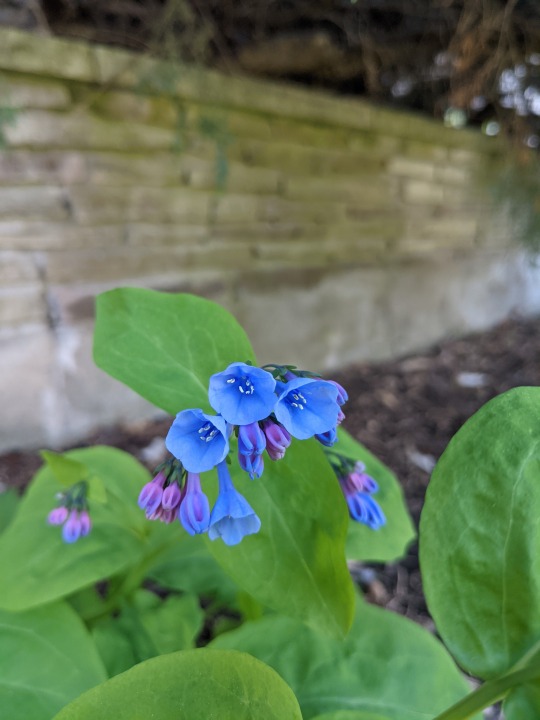



I'm not kidding. They really are that blue naturally. They bloom in May. Then they slowly decline and the entire plants are gone above soil by the summer. Only to reappear the following spring! The shoots and flower buds are edible. You don't want to take too much, though. As spring ephemerals, they need the energy they make with their leaves during their short growing period. The short bloom period is also why I don't have more photos of them. They don't even bloom every year.
#photography#my photos#blackswallowtailbutterfly#Virginia bluebells#Mertensia virginica#flowers#blue flowers#wildflowers#gardening#native species#North American native plants#edible wild plants#my garden#native plants of Ontario and the northeastern USA#spring ephemerals
21 notes
·
View notes
Photo

Canyon de Chelly
Canyon de Chelly or Canyon de Chelly National Monument is a protected site that contains the remains of 5,000 years of Native American inhabitation. Canyon de Chelly is located in the northeastern portion of the US state of Arizona within the Navajo Nation and not too far from the border with neighboring New Mexico. It is located 472 km (293 miles) northwest of Phoenix, Arizona. Canyon de Chelly is unique in the United States as it preserves the ruins and rock art of indigenous peoples that lived in the region for centuries - the Ancestral Puebloans and the Navajo. Canyon de Chelly has been recognized as a US National Monument since 1931 CE, and it is one of the most visited National Monuments in the United States today.
Geography & Prehistory
The etymology of Canyon de Chelly's name is unusual in the U.S. Southwest as it initially appears to resemble French rather than the more ubiquitous Spanish. "Chelly" is actually derived from the Navajo word tseg, which means "rock canyon" or "in a canyon." Spanish explorers and government officials began to utilize a "Chelly,” “Chegui,” and even "Chelle" in order to try to replicate the Navajo word in the early 1800s CE, which eventually was standardized to “de Chelly” by the middle of the 19th century CE.
Canyon de Chelly lies very close to Chinle, Arizona, and it is located between the Ancestral Puebloan ruins of Betakin and Kiet Siel in the west and the grand structures of Chaco Canyon in New Mexico in the east. Canyon de Chelly, as a National Monument, covers 83,840 acres (339.3 km2; 131.0 sq miles) of land that is currently owned by the Navajo tribe. Spectacularly situated on the Colorado Plateau near the Four Corner's Region, Canyon de Chelly sits at an elevation of over 1829 m (6,000 ft) and bisects the Defiance Plateau in eastern Arizona. The tributaries of the Chinle Creek, which runs through Canyon de Chelly and originates in the Chuska Mountains, have carved the rock and landscape for thousands of years, creating red cliffs that rise up an additional 305 m (1000 ft). The National Monument extends into the canyons of de Chelly, del Muerto, and Monument.
Canyon de Chelly is one of the longest continuously inhabited places anywhere in North America, and archaeologists believe that human settlement in the canyon dates back some 5,000 years. Ancient prehistoric tribes and peoples utilized the canyon while hunting and migrating seasonally, but they did not construct permanent settlements within the canyon. Nonetheless, these prehistoric peoples did leave etchings on stones and on canyon walls throughout what is now Canyon de Chelly. Around c. 200-100 BCE, peoples following a semi-agricultural and sedentary way of life began to inhabit the canyon. (Archaeologists refer to these peoples as "Basketmakers." They are considered the ancestors to the Ancestral Puebloan Peoples.) While they still hunted and gathered like their prehistoric forebears, they also farmed the land where fertile, growing corn, beans, squash, and other small crops. It is also known that they grew cotton for textile production. Yucca and grama grass have grown in the canyon for several millennia, and indigenous people utilized these plants when making baskets, sandals, and various types of mats. Prickly pear cactus (Opuntia cactaceae) and pinyon are also found throughout Canyon de Chelly, the latter of which provided an important source of food for indigenous peoples in autumn and winter. Fish are found in Canyon de Chelly's tributaries, and large and small game frequent the canyon.
Continue reading...
42 notes
·
View notes
Text
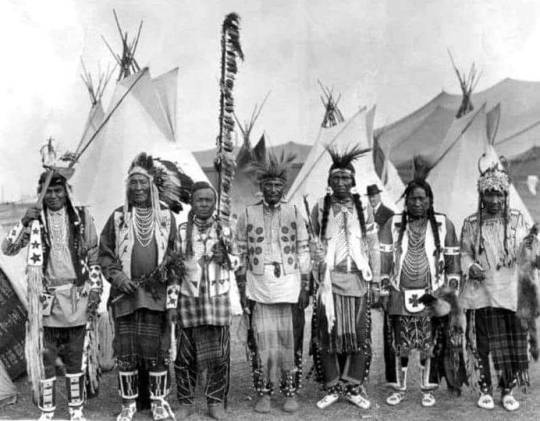
Walla Walla – People of Many Waters
A Sahaptin tribe who lived for centuries on the Columbia River Plateau in northeastern Oregon and southeastern Washington, their name is translated several ways but, most often, as “many waters.” While the people have their own distinct dialect, their language is closely related to the Nez Perce. The tribe included many groups and bands that were often referred to by their village names, such as Wallulapum and Chomnapum ... A hunter-gatherer tribe, they lived in “tents” that were easy to move. However, their lodging differed from many other nomadic tribes, in that it was bigger and covered with tule mats rather than hides. Called a longhouse, it was made out of lodge poles much like a tepee, but was much longer, sometimes as much as 80 feet in length. Resembling a modern-day “A” frame house in appearance, the lodge poles were covered with mats made of tule, a plant that grows freely in the area along waterways. When the tribe moved, the mats were gathered and moved and the lodge poles left behind ... Beginning in the early 1700s the Walla Walla people raised great herds of horses, making their lifestyle much easier as they gathered seasonal plants. They also traveled across the Rocky Mountains to trade dried roots and salmon to the Plains Indians for buffalo meat and hides ... The people were first encountered by white travelers during the Lewis and Clark Expedition in 1805. The explorers were warmly welcomed by Chief Yellepit, whose village of about 15 lodges, was situated on the Columbia River near the mouth of the Walla Walla River. The communication between the two groups was made between a Shoshone woman who had been captured by the Walla Walla and the expedition’s guide and interpreter, Sacagawea, who was also of the Shoshone tribe. Though Yelleppit extended an offer to the expedition to stay with the village, Lewis and Clark were in a hurry to reach the Pacific Ocean. However, they promised to spend a few days on their return. In April 1806, as the explorers began to make their way back east, the expedition spent several days with the Walla Walla, during which time, gifts were exchanged and goods traded. Two of the items left by the expedition with the tribe was a peace medal engraved with a portrait of Thomas Jefferson and a small American flag. In their documentation, Lewis and Clark estimated the tribe’s numbers as 1,600; however, this probably included other bands now recognized as independent ... The next non-native to encounter the Walla Walla people was a trader by the name of David Thompson of the Canadian-British North West Company, who arrived in 1811. About five miles upriver from Chief Yellepit’s village, he staked a pole with a note claiming the territory for the British Crown and declaring that the North West Company intended to build a trading post at the site. Continuing downriver, Thompson stopped at Yellepit’s village, where he discovered the American “claims” in the form of Yellepit’s flag and medal. Though neither Lewis and Clark or Thompson had much power to actually lay claim to the region, Yellepit was very supportive of the idea of Canadians setting up a trading post nearby ...
35 notes
·
View notes
Text
In early August of 1864, a contingent of thirty-six U.S. soldiers, led by an army captain named John Thompson, left Fort Defiance in the northeastern corner of Arizona Territory and trudged north under the hot sun through the sprawling homeland of the Navajos. Diné Bikéyah, as Navajos call their land [...]. He and his thirty-six men headed straight from Fort Defiance to the deep gorge at the heart of Diné Bikéyah -- Tséyi’ or Canyon de Chelly, the now-famous canyon lined with swaying cottonwoods and pockmarked with ancient Pueblo ruins. As Thompson and his men marched through the canyon, [...] they engaged in a fierce, and roundly victorious, battle against an unlikely enemy: the peach orchards that had been cultivated over hundreds of years by Diné families. In the course of his march, Thompson and his soldiers felled a remarkable 4,150 fruit- bearing peach trees and, for good measure, “effectually destroyed” at least eleven acres of corn and beans. Oddly, these binges of violence against Navajo peaches, corn, and beans came after the majority of Diné in the area had already surrendered to the army, following an aggressive and violent campaign for their removal from the canyon. [...]
---
We can ask, of course, just what it was about these peach trees, corn stalks, and bean plants that invited such unnecessary violence, such “systematic eradication” of fruits, grains, and legumes.
Historian Peter Iverson muses, “perhaps the army simply wanted to remove evidence that contradicted the image of Navajos as full-time nomadic wanderers,” which had provided the (quite effective) rationale for their removal in the first place. Perhaps, too, the orchards and fields evidenced a Diné proficiency at agriculture in the high arid climes of the New Mexico territory that surprised Americans who expected Navajo country to be useless for agricultural purposes, a sprawling wasteland described in 1868 by William Tecumseh Sherman, the general of Union Army fame, as “utterly unfit for white civilization.” It is not implausible to venture a guess that these binges of violence against peach trees occurred as proxy to settler and soldier frustrations about the newly conquered Southwest and the challenges it presented to American notions of what good agricultural land should look like. Indeed, ideas about landscape and people, throughout this notorious removal campaign, served as the primary and most powerful impetus for colonial violence against people and peaches alike. Notions that the Colorado Plateau was uninhabited wasteland unfit for farming draw us quite a clear map of how we get from Thompson and his vexed tree felling to more contemporary cases of the interplay between nature, people, colonization, and power. [...]
---
The social construction of the high, arid landscapes of the Southwest as “more or less worthless” has been a fundamental component of colonization of the Diné, as well as other southwestern and Great Basin tribes. In fact, the inhabitation of dry, arid landscapes by Native nations was used as evidence of their low status on the Western hierarchy of civilization, following a kind of environmental determinism that posited that “barren” landscapes supported villainous and savage peoples. [...]
The surviving Diné were to return to Diné Bikéyah, and General Sherman, who made the final decision to permit the Diné to return to their homeland, did so believing that he was sending them to what he considered, as one historian put it, a “waterless worthless waste” -- certainly not the kind of land [...] that would support fine orchards of thousands of fruit trees and scores of acres of beans and corn. In fact, upon returning to Diné Bikéyah, the Navajos of Canyon de Chelly masterfully regrew their orchards and, by the 1880s, were harvesting peaches once more.
---
Text by: Traci Brynne Voyles. “In Search of Treasure.” Wastelanding: Legacies of Uranium Mining in Navajo Country. 2015. [Some paragraph breaks/contractions added by me.]
246 notes
·
View notes
Note
im curious to your thoughts as a known fallout 4 lover, there's starting to be discussions on the fallout 4 settlement building and a good chunk of it is seeming negative, more because they're louder then they have a majority, but if i remember right I'm pretty sure you engaged a lot with it, so I was wondering if you had any thoughts
OH BOY DO I HAVE THOUGHTS.
The settlement building is AWESOME….with mods. A lot of mods.
See, the problem is that the devs kind of created two games and smashed them together. One is an open-world retrowave RPG with elements of being a FPS. This is in keeping with earlier entries in the Fallout series and is comparable to games like the Half-Life series and Bioshock.
The other one is a post-apocalyptic quest-based community/world-building game that’s so akin to early versions of SimCity that there’s an entire VERY LARGE mod package called SimSettlements that aims to bring it in line with more modern versions of SimCity. I’m not the only one making this comparison—SimSettlements and SimSettlements 2 are so large and so popular that the Nexus (basically the Amazon.com of video game mods) has an entire tag section for them.
Here’s the problem: both of these are great games. But like a perverse peanut butter and chocolate, when you smush them together, it comes at the expense of both. Previsibines necessary for good framerate in combat mean limited ability to clean up trash; time spent on the scrapping system took precious time away from quest-writing because they had to stay under budget. Basically the entire northeastern section of the map is a total barren wasteland with two quests so minor they actually have NPCs elsewhere directing you to go check out Salem, and we know—because actual devs have told us so—that there was a lot more planned for Salem, but it had to be scrapped due to other stuff coming in last-minute. You want to know what we can tell was a late addition to the game? SETTLEMENTS. Settlements are a decent guess for what killed Salem. I’m actually in Salem right now with three mods installed (adding a workshop—the irony is not lost on me—along with Beantown Interiors and Immersive Salem), and it’s shocking to me to spot what the mods have added and realize how LITTLE was up here without those mods. And I wouldn’t even have been up here if I hadn’t been chasing a monster from ANOTHER mod, Mutant Menagerie, and there literally would have been nothing else to drag me northward enough if not for MORE mods that add additional random encounters and more named NPCs! (Sidenote: please be aware MM includes both giant spiders and a creature whose name was taken from Native American folklore and should not be spoken. If you loved the idea of dozens more monsters and plants until you read that last part, there is a mod that renames the creature to something more appropriate. The mod author took a lot of abuse in the 24-or-so hours they had comments turned on so if you want to use that mod, consider sending a friendly NexusMail to the author with thanks.)
Thus: I think criticism of the settlement system comes from four main places:
1) People who would like it if it didn’t have extremely limited capabilities that make vanilla settlement-building more frustrating than fun (these people are so valid)
2) People who might or might not like it if it was a different game, but they came here to play a shooting game, not a building one, and they’re unhappy that you basically have to have settlements to do a lot of meaningful stuff like having access to weapon and armor mods (these people are confusing to me because I love settlements, but also valid)
3) People who have certain expectations of the game because it’s an entry in a well-known and well-established series, and they’re upset that FO4 is such a departure from FO1-3/FNV (these people need to learn that clone games are a great way to kill a series but also I do kinda understand where they’re coming from)
4) People who will complain about every single thing in FO4 simply because it’s FO4, often accompanied by rhapsodies about how New Vegas was so much better and we should all be playing New Vegas and you kind of get the feeling they’d fuck New Vegas if they could (I cordially invite these people to make sweet love to a rabid deathclaw)
Are there others? Yeah, sure. I’ve seen a few people who dislike it because it’s poorly integrated in ways that almost make it feel like an afterthought, and frankly, that’s one of my major complaints with it as well. I suspect a lot of other players who are ambivalent-to-positive about the settlement system will agree with me that Coastal Cottage and Murkwater are both really stupid locations for settlements, and everyone who likes settlements has That One Location That Would Be Perfect For A Settlement Why Isn’t There A Settlement There. (Mine is Forest Grove Marsh, and I await the day someone actually makes a mod for that, because I very can’t.)
But as someone who has more than 100 settlement-related mods for everything from better placement to greater furniture options to more crops to additional settlement locations, I suspect #1 on the list of “why people hate settlements” is almost certainly down to Bethesda aiming too high for a single game. If you fully optimized both combat and settlements—I can say this because I can add the sizes of my mods together—it would double the size of an already-huge game file. As a result they pared down both, to the detriment…of both.
5 notes
·
View notes
Text

a piece i did for a class on native american history, inspired by Murder on the Red River by Marcie Rendon (more info under cut)
“She bounded down two concrete stairs and stepped out on to the green grass of the campus mall, surrounded on either side by thick stately oaks. She could tell each one had been strategically planted along the winding sidewalks between the red brick buildings. Even with groups of students sitting on the grass, leaning against their trunks, the trees seemed lonely. Nothing like the oaks along the river that grew where they wanted to grow and leaned in and touched each other with their middle branches, whose voices sang through their leaves like the hum of electric wires running alongside the country roads.” From Murder on the Red River
This piece is inspired by Murder on the Red River, a mystery novel by Marcie Rendon. It’s about Cash Blackbear, a young Ojibwe woman who investigates the murder of a Native man. Cash was taken from her mother and siblings as a young child and lived in a series of foster homes, most of which were abusive.
About a third of Native American children were taken from their parents and placed in foster homes, even when they could have been placed with relatives instead of being separated from their community members and culture. Native American boarding schools, which also separated children from their families and culture, had mostly all been shut down by the 1970s (Katherine Beane), when Murder on the Red River takes place. But the removal of children to foster homes was just another way that the government tried to force Native Americans to assimilate into white culture. The Indian Child Welfare Act was passed in 1978. It set requirements to keep Native children with relatives when safe and possible, and to work with the tribe and family of children. This act has made progress, though Native children are still adopted or placed in foster care at a higher rate than non-Native children (NICWA).
In my illustration, there are four trees, representing Cash, her mother, and her two siblings. In the image on the right, the trees are growing as they do in their natural forest habitat, winding together. In the image on the left, the trees have been planted on the neat lawn of the college campus, a place where white culture is dominant. The trees are apart from each other, separated as Cash’s family were torn apart. They were forced to assimilate as many Native Americans were. The trees are bur oaks, aka Quercus macrocarpa, a species native to North Dakota where the book takes place. Their range encompasses much of the U.S. and parts of Canada (Lady Bird Johnson Wildflower Center). The grass on the right image is Kentucky Bluegrass, aka Poa pratensis. It is invasive to North America. It was introduced in the 17th century from Europe, and is now found all over North America. It is commonly used for lawns and pasture, and can outcompete native prairie plants (North Dakota State Library). The Red River borders North Dakota and Minnesota. The Ojibwe have lived in Minnesota since before the 17th century, after migrating from Northeastern North America over hundreds of years (Minnesota Historical Society). The shape of the Red River traces through the image, weaving and intermingling through the branches of the trees, showing Cash’s deep connection with the land she is from.
Works Cited
“About IWCA” National Indian Child Welfare Association, https://www.nicwa.org/about-icwa/
Beane, Katherine, American Indians in Minnesota, 12 March 2024, Nicholson Hall, Minneapolis, MN. Lecture.
“Kentucky Bluegrass”, North Dakota State Library. https://www.library.nd.gov/statedocs/AgDept/Kentuckybluegrass20070703.pdf
Rendon, Marcie. Murder on the Red River. Soho Crime, 2017.
“The Ojibwe People”, Minnesota Historical Society, https://www.mnhs.org/fortsnelling/learn/native-americans/ojibwe-people
“Quercus macrocarpa”, Lady Bird Johnson Wildflower Center, https://www.wildflower.org/plants/result.php?id_plant=QUMA2
2 notes
·
View notes
Text

The Narragansett Turkey (Pictured, an animal at the Knoxville Zoo) is an historic breed Named after Rhode Island's Narragansett Bay. It's a cross between the wild turkey and domestic turkey. Photograph By Joel Sartore, National Geographic, Photo Ark
Wild Turkeys Are at a Record High in New England—But Not All are Thankful.
When Turkeys were Reintroduced about 50 Years Ago, No One Dreamed the Birds Would Thrive in the Suburbs. And now, They’ve Become a Nuisance.
— Published: November 25, 2019 | Updated: November 20, 2023 | By Brian Handwerk
Amherst, New Hampshire— Wild turkeys are a familiar sight throughout New Hampshire, where flocks strut along roadsides and wander through backyards.
Ted Walski knows this better than anyone: He’s the man responsible.
In 1975, the biologist for New Hampshire Fish and Game released 25 turkeys from the back of his truck in Walpole, a town in the western part of the state. It was part of a reintroduction effort to bring back a species that had been wiped out in New England before the Civil War, thanks to a one-two punch of vanishing forests and unchecked hunting.
“Originally, I never thought it would get beyond a few thousand turkeys,” says Walski, who spent nearly 50 years working with the birds before retiring in 2019.
Instead, New Hampshire’s turkey population has exploded beyond all expectations, and now hovers around 45,000 animals—the highest since reintroduction, and probably the most the state can handle. Reintroduction efforts in neighboring states and around the country have created a similar story—there are 70,000 wild turkeys in Maine, up to 50,000 in Vermont, and more than 30,000 in Massachusetts—all of which totals up to about six million animals reproducing in every state but Alaska.
So what made the wild turkey one of the most successful wildlife reintroduction programs in American history? Most likely, it’s due to the bird’s surprising—and unexpected—ability to live among humans. In the suburbs, turkeys can take advantage of edge habitat, like woods and open spaces, and dine on a never-ending buffet of food provided by people—particularly birdseed. It doesn’t hurt that native predators, such as wolves and cougars, have also largely disappeared from most parts of the turkey’s range.
But not everyone is thankful for the New England turkey boom. The notoriously bold birds are a nuisance, disrupting traffic and pecking at front doors (or, a police station a few days before Thanksgiving), as well as potentially dangerous: In 2019, a 35-year-old pregnant woman was attacked by turkeys on the streets of Cambridge, Massachusetts—twice. As conflicts between these 20-pound birds and people are on the rise, particularly during the spring breeding season, wildlife officials are trying to cope with the reality that the turkey is here to stay.
“I would wager that 40 years ago nobody expected there to be booming turkey flocks in suburban and urban areas,” says David Scarpitti, a wildlife biologist with the Massachusetts Division of Fisheries and Wildlife. “But it’s pretty obvious that they aren’t just passersby.”

A flock of wild turkeys walk on a suburban driveway in West Newbury, Massachusetts. Photograph By Frank Vetere, Alamy
How Turkeys 🦃 🦃 🦃 Came Back
In 1634, William Wood noted the abundance of turkeys in his book “New Englands Prospect,” writing that “sometimes there will be forty, three score, and a hundred in a flocke, sometimes more and sometimes lesse.” According to Wood, unregulated hunters in the 17th century might kill 10 or 18 turkeys a day, a practice that essentially doomed the northeastern populations.
In the 1960s and 1970s, many U.S. states reintroduced turkeys back into their native habitat, where the omnivores play a vital role of keeping several plant and invertebrate populations in check. Walski captured his original 25 birds from the Allegheny Mountains on the New York-Pennsylvania border, releasing them along the fertile Connecticut River Valley, on the border with Vermont.

A female turkey pauses at a doorway on Mt. Auburn Street in Cambridge, Massachusetts. Photograph By Craig F. Walker, The Boston Glob/Getty Images
Initially, Walski targeted farmlands because there was evidence that turkeys needed to supplement their diet—nuts and acorns—with farm foods, such as manure and discarded corn, in the winter.
Yet apparently turkeys were tougher than thought, as they have continued to thrive despite a massive decline in New Hampshire dairy farms—from more than 600 in 1975 to under a hundred today.
Much of their survival is due to backyard birdfeeders, he says. “When you’ve got a couple of feet of snow in the middle of the winter, that’s their salvation," Walski says.
Turkey 🦃 Troubles
One community with a notable increase in wild turkeys is Brookline, Massachusetts, a suburb near Boston.
“I grew up in Brookline, and as a kid in the 1990s, I don’t remember ever seeing turkeys,” says David Cheung, a former animal control officer for the Brookline Police Department. “Now there’s a flock that hangs out at the high school. And the number of calls we get about turkeys definitely keeps increasing.”
Without hunting and predators, “we don’t have any population control for turkeys,” he says. The city has euthanized a few birds over the years—a few of them were injured—but it’s not an official policy.
Most of the conflicts with the birds stem from their tendency to parade through the streets, blocking traffic. “Motorists are like a deer in the headlights. They don’t know what to do, so they just stop,” Cheung says. That leads to another problem: Turkeys will often attack their reflection in a car’s shiny exterior. “You’ll see turkeys pecking at someone’s car, and the motorist will just be in shock and not know what to do.” (Read our tips for how to stay safe around wild animals.)
Turkeys have always been plucky: New Englander Ben Franklin made note of their feisty nature in a 1784 letter to his daughter, noting that the birds “would not hesitate to attack a grenadier of the British guards who should presume to invade his farm yard with a red coat on.”
But what’s different now is that turkeys are learning how to live in urban environments, Scarpitti says.
“The more familiar they get with people, the more they are apt to demonstrate this [dominant] behavior that’s rooted in their biology. They do it to each other all the time. But when they have no fear of humans, they kind of assimilate humans into that routine.”
Coexisting
Of course, many people enjoy seeing wild turkeys; the male’s impressive plumage, for instance, is a sight to behold. In a 2022 New Hampshire Fish and Game Survey, just one percent of all respondents said they “Strongly Disliked” Turkeys.
“It’s astounding, even to me, that in our surveys over 97 percent either like or strongly like turkeys,” Walski said. “It’s only a percent or two that have some ax to grind.”
Many urbanites seem to agree. “A lot of [Brookline] residents find it fascinating for these animals to be in the city, and that’s one of the things that drives people to feed them,” Cheung says.
But what’s best for both turkeys and people is to avoid feeding them—and that includes ditching the birdfeeders, wildlife managers say.
Other strategies for coexisting with turkeys are protecting gardens (for instance covering plants with netting), obscuring reflective surfaces that might trigger a territorial turkey, or hazing birds that come too close with loud noises or a water hose.
Tough Old Bird 🦃
In much of the Southeast and New York, where wild turkeys experienced similar comebacks in the latter half of the 20th century, the bird’s numbers have dropped in recent decades.
So it’s possible that may also happen in New England, where reintroduction occurred later than in those other states, says Matt DiBona, a wildlife biologist at the National Wild Turkey Federation, a nonprofit dedicated to promoting wild turkey hunting and conservation.
“There is the potential for increased predators, declining nesting success, disease—those are all pressures that we might expect to apply to New England turkeys,” DiBona says.
But Scarpitti suspects that New England’s suburban turkeys may have found a niche so robust that they’re insulated against such changes—and even New England winters may not be a deterrent.
“The conditions that we had that winter of 2014-15 are the worst situation possible for wild turkeys, and by my estimation it had pretty much zero effect on the turkey population because they are so buffered by that supplemental food,” he says. “So if populations didn’t drop that year, I just don’t think it’s going to happen.”
Instead, it seems likely that turkeys will become as familiar a sight in America’s backyards as they are on our Thanksgiving dinner plates.
4 notes
·
View notes
Text
nerd time!! spidersona research!!!
if you see something that is incorrect please let me know!!!!
Yellow Sac Spider/Cheiracanthium
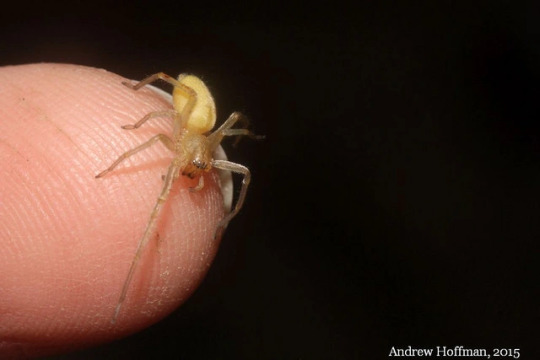


Bite: Creates surface lesion with redness, swelling, burning. Medical attention recommended. Venom is slightly necrotic to humans
Behavior: Bites without reason, hunter (actively chases prey), cannibalistic, most common spider bites. Nocturnal. Do not jump, fast moving, escapes with silk when startled.
Habitat: Gardens, bushes, trees, during cold weather may seek shelter in houses. Northeastern United States, range expanded in recent decades, central Europe.
Size: Females body size range 5-9mm, males 4-8mm. Leg span 2.5cm/1in. Front pair of legs are longest. Males have more slender bodies.
Coloration: Light yellow body, brown jaws, darker legs, vertical dorsal stripes on abdomen. Males are darker. Diet can affect coloration
Body: Scopulae allows them to cling to smooth surfaces like glass, 8 eyes
References: Nebraska University dep of entomology, Wikipedia, WebMD,
Note: I lost some of my references for this entry - take with a grain of salt
Yellow Amycine Jumping Spider
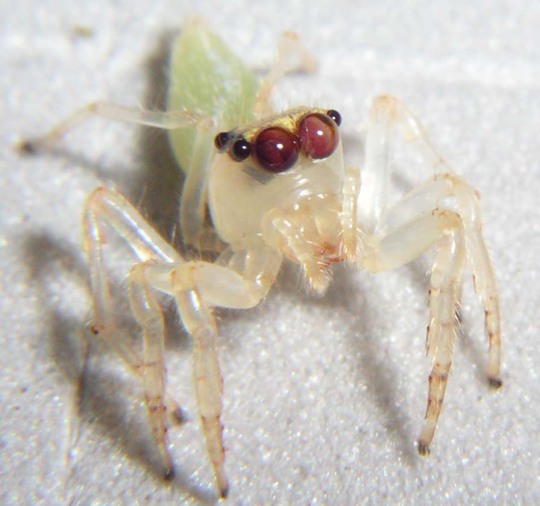


Note: I will be refrenceing Amycine when I can but not much is known about the species
Bite: Unlikely to bite humans, usually runs away. Causes redness, itching, stinging, and swelling. Can be cleaned with soap and water, does not require medical attention
Behavior: Can move rapidly sideways and backwards, pounce on prey. Can jump 20-50 times their body length, use silk dragline when jumping as safety line. Jumping is caused by sudden blood flow change, fully extending legs. Eats insects and other spiders, may drink nectar and plant matter. Hunts during the day.
Habitat: Vegetation, rocky areas, very widespread - no specific habitat. Not found in Greenland
Size: 3.175mm/0.75in, have larger front legs
Coloration: Extremely translucent, eye cones are visible. Joints are dark due to blood flow.
Eyes: Has two eyes on the front, two on each side, and two on the back of their head
References: Wikipedia, US Dept. of Agriculture, Washington State, PestWorld.Org, Michigan State
Striped Lynx Spider



Bite: Little danger to humans, only cause temporary pain and swelling.
Temperament: Daytime ambush predator, nimble. Can shoot venom 20cm/7.9in, only observed in adult females. Strong sense of smell to detect prey. Consuming nectar early in life can deter cannibalism and lengthen lifespan somewhat. Jumps and uses dragline like jumping spiders, is not classified as one.
Habitat: Native coast to coast of southern United States, Mexico, Central America, and the Caribbean. Lives at the top of vegetation in open areas like fields and backyards. Most well seen in Florida and American South.
Size: Females 5.7-6.7mm, males 4-4.5mm and more slender. Fangs are large in proportion to head
Coloration: Pale yellow, can adjust coloration. Males resemble females, but are iridescent that can appear coppery, silvery-green, or purple. Males are usually more red/orange
References: North American Insects & Spiders, University Florida, University Florida, University Florida, iNaturalist
Other spiders I want to look at later: Heliophanus flavipes, Telamonia dimidiata, Crab spiders, Misumena vatia, orchard orbweaver
Note: Always do your own research!!! Doubt the information I gave you!!!
#spiders#spidersona#refrence#Entomology#spider tw#true spiders#Cheiracanthium inclusum#Salticidae#jumping spider#Oxyopes salticus#Striped Lynx Spider#yellow sac spider
4 notes
·
View notes
Text
April's Pink Moon: Origins and Spiritual Meaning Explained

April's Pink Moon: Origins and Spiritual Meaning Explained
As April's Pink Moon approaches, anticipation builds for one of the year's most prominent celestial events. Despite its name, this second full moon of spring doesn't actually appear pink. However, its significance transcends its color, offering a unique opportunity for personal growth and reflection.
Scheduled to rise on Tuesday and remain visible until Thursday, this year's Pink Moon coincides with the beginning of the Jewish holiday Passover, earning it the alternate title of Passover Moon. Positioned in the Scorpio constellation, known for its associations with intimacy, self-empowerment, and renewal, the April 23 full moon symbolizes a rejuvenation of energy and spirit.
When to Witness the 2024 Pink Moon?The Pink Moon isn't the sole celestial attraction this year. Alongside its luminance, planets like Mars, Saturn, and Mercury will also be visible.
According to NASA, the Pink Moon will reach its peak illumination at 7:49 pm EDT on April 23, remaining visible throughout Thursday morning. Known by various names across cultures, including the Sprouting Grass Moon, Egg Moon, and Fish Moon, its significance extends beyond astronomy. In Christian tradition, it also serves as the Paschal Moon, determining the date of Easter.
Why is it Named the Pink Moon?The Pink Moon derives its name from Native American traditions, particularly those of the northeastern United States. Inspired by the early spring blooming of the moss pink wildflower, tribes in this region referred to the April full Moon as the Pink Moon due to its association with this vibrant plant.
As the Pink Moon aligns with the Scorpio constellation, its spiritual significance is heightened. Symbolizing renewal and self-discovery, it encourages individuals to shed old habits and embrace positive change. This period of introspection offers an opportunity for personal growth and transformation, inviting individuals to become the best versions of themselves.
Read the full article
0 notes
Text

(Edit) Red Spotted Purple on Wild Bergamot - August 13th 2023
#butterflies#northeastern american native plants#photographers on tumblr#original phography#nature#monarda fistula#summer#njlocal#new jersey#schooleys mountain
54 notes
·
View notes
Text
Michigan lilies (Lilium michiganensis)
These are from my garden. Unedited. They're also the real deal. Not a cultivar, not a hybrid. They really grow like this in the wild.

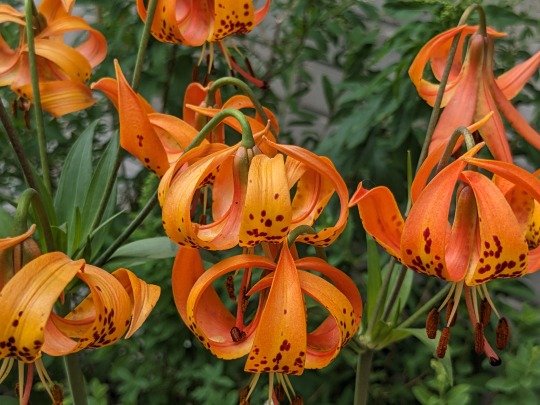

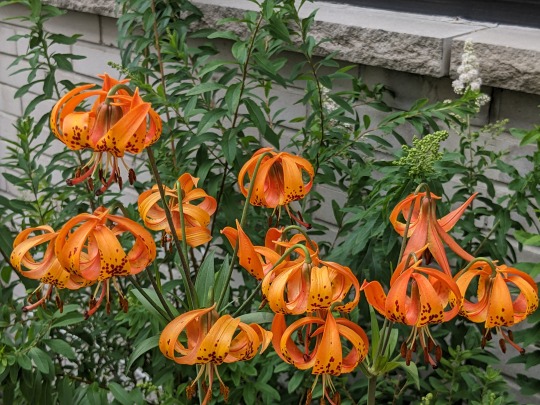







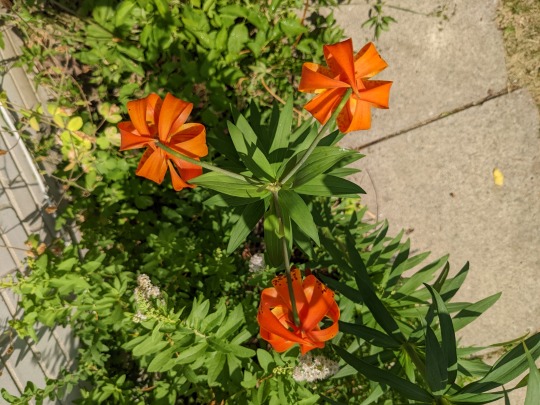
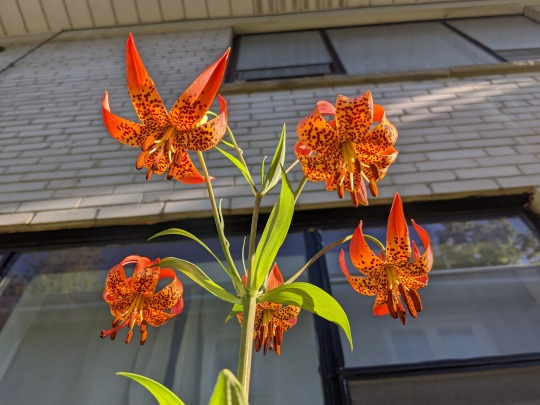

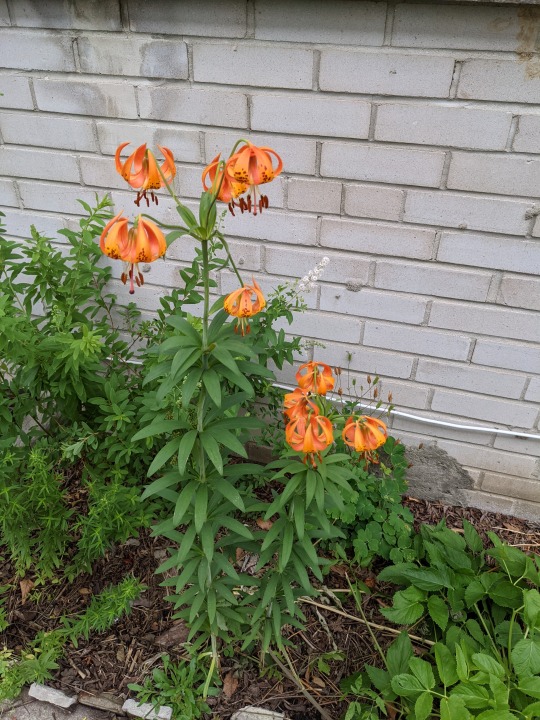
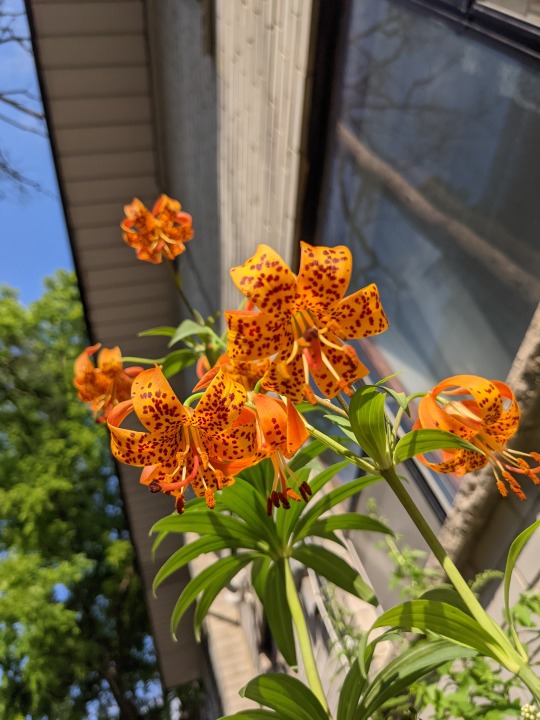
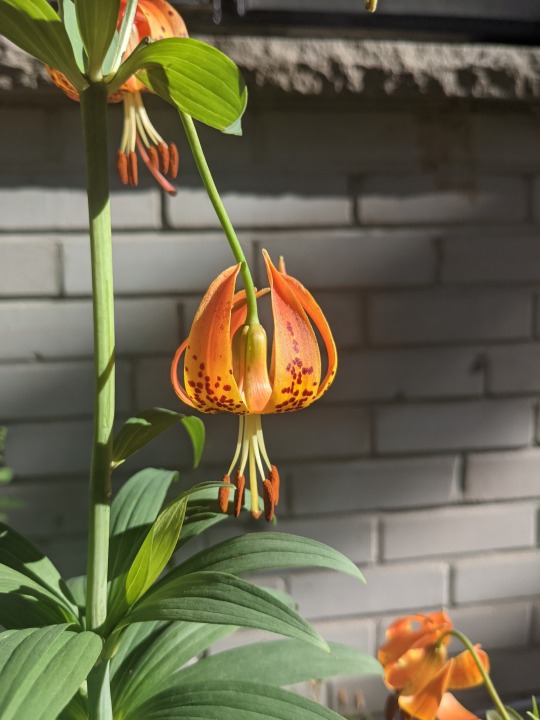



They bloom in June and spread slowly but exponentially. Flower petals and bulbs are edible cooked (all parts are toxic to cats and dogs though). :)
#photography#my photos#blackswallowtailbutterfly#Michigan lily#Lilium michiganensis#flowers#lilies#true lilies#orange flowers#wildflowers#gardening#native species#North American native plants#edible wild plants#my garden#native plants of Ontario and the northeastern USA
7 notes
·
View notes
Text
Itea virginica Virginia Sweetspire


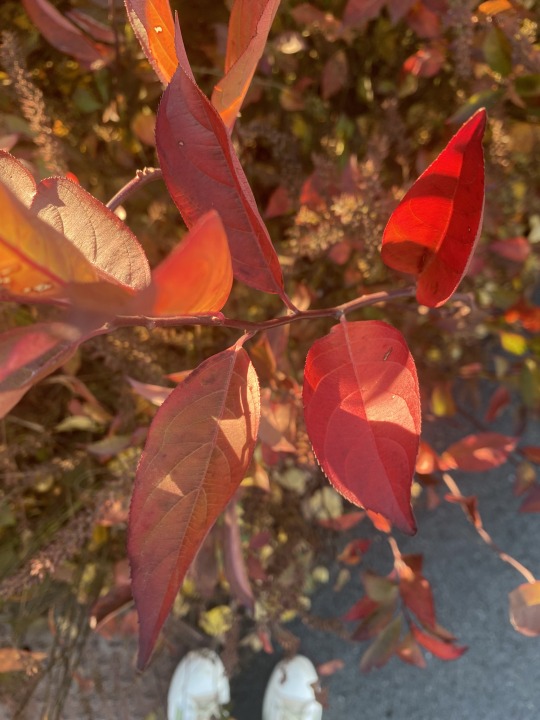
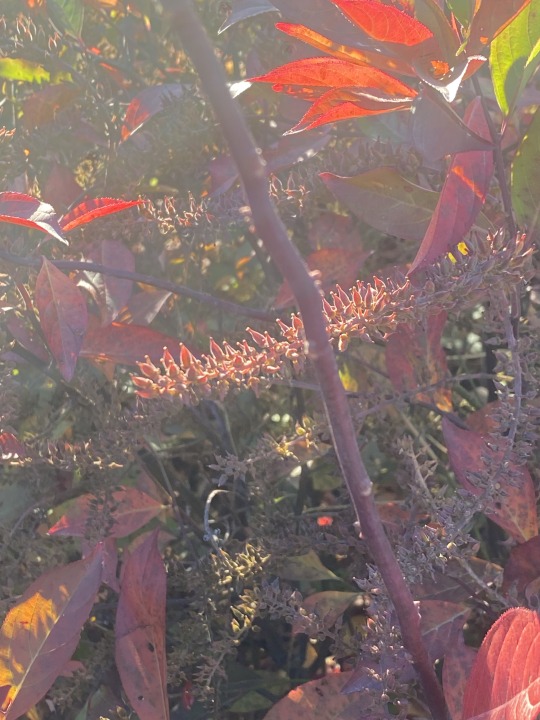
This plant was photographed on Northeastern University's arboretum near Carter Field. The plant itself is very spread out and has a beautiful red color
Basic Facts
This deciduous shrub is native to Eastern North American and has cold hardiness zones of 5 to 9. This plant prefers full sun to part shade and medium to wet, well drained soil. It can tolerate a wide range of soil conditions however. The branches arch and you can expect this plant to grow 3 to 5 feet in height and the same in spread.
Design
This plant blooms later in the year; around June to July. The flowers are tiny and white. The fall color is very attractive and vibrant, so consider these factors when designing. It can be used in mass for ground cover and is great for any wet locations. Consider using this plant for woodland gardens, shrub borders, or hedges
Bird Attraction
Although the flower on this plant attracts insects and pollinators, the raceme flowers become capsules with seeds that act as food for bird. This plant not only provides food for birds, but also cover. Many species of birds rely on the foliage of this plant for cover and habitat
Sources
https://www.clemson.edu/cafls//demo/plant_profiles/itea-virginica.html#:~:text=These%20fragrant%20flowers%20also%20attract,gold%20during%20the%20fall13.
https://www.missouribotanicalgarden.org/PlantFinder/PlantFinderDetails.aspx?taxonid=286893
0 notes
Text
Native Birds and Plants: More than Footnotes in the Landscape from the American Bird Conservancy
#Native Birds and Plants: More than Footnotes in the Landscape#American Bird Conservancy#Natural Connections#Birding#Bookshelf#Tumblr Staff Has Ruined Links Now And I Hate Them For It#Prairie Magic & Medicine
0 notes
Text

The Hopi are a Native American tribe who primarily live on the Hopi Reservation in northeastern Arizona, United States. As of the 2010 census, there are 19,338 Hopi in the country.[1] The Hopi Tribe is a sovereign nation within the United States and has government-to-government relations with the United States federal government. Particular villages retain autonomy under the Hopi Constitution and Bylaws. The Hopi language is one of 30 in the Uto-Aztecan language family. The majority of Hopi people are enrolled in the Hopi Tribe of Arizona but some are enrolled in the Colorado River Indian Tribes. The Hopi Reservation covers a land area of 2,531.773 sq mi (6,557.26 km2The Hopi people trace their history in Arizona to more than 2,000 years, but their history as a people goes back many more thousands of years. According to their legends, the Hopi migrated north to Arizona from the south, up from what is now South America, Central America and Mexico ... The tribe’s teachings relate stories of a great flood and other events dating to ancient times, marking the Hopi as one of the oldest living cultures in documented history. A deeply religious people, they live by the ethic of peace and goodwill ... The Hopi Reservation, in northeastern Arizona, occupies part of Navajo and Coconino counties and encompasses approximately 1,542,306 acres. Having inhabited this high and dry area since the 12th century, the Hopi have developed a unique agriculture practice, “dry farming.” Instead of plowing their fields, Hopi traditional farmers place “wind breakers” in the fields at selected intervals to retain soil, snow and moisture ... They also have perfected special techniques to plant seeds in arid fields. As a result, they succeed in raising corn, beans, squash, melons and other crops in a landscape that appears inhospitable to farming ... Throughout the Hopi reservation, every village is an autonomous government. However the Hopi Tribal Council makes law for the tribe and sets policy to oversee tribal business ...
15 notes
·
View notes
Text
Blue Lyretail Guppies & 6 Fascinating Facts
General Introduction to Blue Lyretail Guppies
Blue Lyretail Guppies are a popular and eye-catching breed of guppies due to their elegant and long caudal fins that resemble a lyre. With their bright blue color and graceful shape, they add a touch of beauty to any aquarium. In this essay, we will discuss Blue Lyretail Guppies in general, including where they live and what type of tank they require, what they eat, how they breed, common health problems, how to avoid them, special considerations, and any legal restrictions.
Details about the entire situation
Origin:
Guppies, like the Blue Lyretail, are native to South American rivers and streams with clean water. They are thought to have originated in the northeastern part of South America, which includes Venezuela, Guyana, and Brazil.
Size:
Male Blue Lyretail Guppies average 1.5 to 2.5 inches (3.8 to 6.4 cm) in length, while females average 2 to 3 inches (5 to 7.6 cm).
Lifespan:
Blue Lyretail Guppies typically live for 2 to 3 years. However, with the proper care and living conditions, they can sometimes live longer.
Temperament:
Blue Lyretail Guppies are generally calm and friendly fish. They are not aggressive, so they can coexist peacefully with other fish species. However, they should not be kept in the same tank as aggressive or fin-nibbling fish because their long, delicate fins could be damaged.
Appearance:
Lyretail in Blue Guppies have a distinct and intriguing appearance. They have long tail fins that resemble a lyre or other musical instrument, hence the name "Lyretail." Males have bright blue bodies and fins, while females have more subdued colors. The males' dorsal and anal fins are also long, adding to their overall beauty.
Colors and types:
Blue Lyretail Guppies come in a variety of patterns and blue shades. Their bodies and fins are usually blue, but they can also be silver, gold, or black. Complex patterns, such as spots or stripes, may also appear on the fins. Blue Lyretail Guppies are attractive aquarium fish that come in a variety of colors and patterns.
habitat and tank requirements
Natural Environment:
Blue Lyretail Guppies inhabit freshwater streams, rivers, and ponds with abundant plant life. These locations provide them with numerous hiding spots as well as a diverse diet of small insects, larvae, and plant matter.
Tank Dimensions:
A small group of Blue Lyretail Guppies requires at least 10 gallons (38 litres) of tank space. However, larger tanks, such as 20 gallons (76 litres) or more, provide more swimming space for the fish and keep the water more stable.
Water measurements:
Blue Lyretail Guppies thrive in water conditions similar to those found in the wild. This breed thrives in water temperatures ranging from 72 to 82°F (22 to 28°C). The pH should range between 6.8 and 7.8. This is the most suitable range.
It is critical to maintain high water quality by testing and monitoring ammonia, nitrite, and nitrate levels on a regular basis. To keep the fish healthy, the aquarium must be properly cycled and have adequate filtration.
Tank Configuration:
It's critical to have a good mix of open space for swimming and areas with lots of plants when setting up a tank for Blue Lyretail Guppies. Live plants such as Java moss, Amazon sword, and Vallisneria can be added to the tank to mimic the fish's natural environment and provide hiding spots.
A sandy or fine-grained base is ideal because it allows animals to behave naturally when looking for food. You can also create a good breeding environment by putting up floating plants or using a spawning mop.
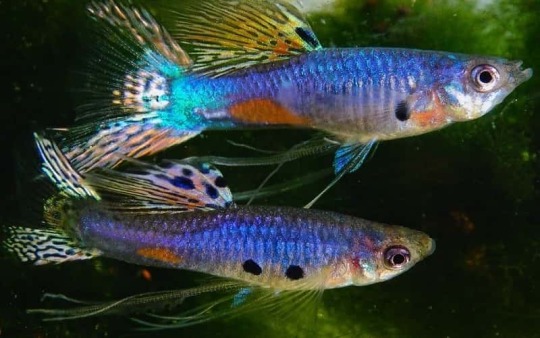
Feeding
Diet:
Lyretail in Blue Guppies are omnivores, meaning they consume both plants and small animals. Feed them a varied diet of high-quality flake or pellet food designed specifically for guppies. Adding live or frozen foods like brine prawns, daphnia, or bloodworms to their diet also provides important nutrients and aids in color improvement. It's critical to feed them small amounts several times a day so they don't overeat and get enough nutrition.
What they eat:
Lyretail in Blue Guppies are always on the go and eat whenever they can. They will swim right up to the water's surface to eat food that floats there, and they will search the tank for food particles. It's fascinating to watch them eat because they catch live or frozen prey so quickly and accurately. Giving them a variety of food sources encourages their natural instincts to seek food, which improves their overall health.
Breeding
Reproduction:
Lyretail in Blue Guppies are famous for having a lot of babies. They give birth to fully formed fry rather than eggs. Females can keep the sperm from one mating for a few months, allowing them to have multiple batches of fry without mating again.
How to Become Pregnant:
It is critical to keep the tank in good condition so that the fish can breed. This includes providing pregnant women with safe havens, such as dense vegetation or floating plants. Water temperature should be kept between 75 and 82°F (24 and 28°C), and water quality should be maintained by changing the water frequently. To avoid overburdening the females, the male-to-female ratio should be 1:2 or 1:3.
Babies are born in the following ways:
Lyretail in Blue Guppies reproduce through courtship, mating, and the subsequent development of fry. To attract females, male guppies display their bright colors and long fins. Swimming in a "zig-zag" pattern and spreading out the fins are part of the courtship display. They mate when the female is ready, and she becomes pregnant with fertilized eggs. A female fish is usually pregnant for about 4 weeks before giving birth to live fry. The fry can swim and eat on their own soon after birth, but they may still need places to hide if they don't want to be eaten.
Most Health Issues:
Blue Lyretail Guppies, like other types of guppy, are typically tough and resilient. They can, however, develop common health issues such as:
Ich (White Spot Disease) is a parasitic infection that appears as small white spots on the body and fins of fish. It is treatable with the proper medications and by changing the temperature of the water.
Fin Rot: Fin rot occurs when a fish's fins begin to fall apart. This is usually the result of poor water quality or bacterial infections. Keeping the water in good condition and treating it properly can help prevent and solve this problem.
Fungus infections can manifest as cotton-like growths on the fish's skin or fins. You can treat them with antifungal medications and by improving the water.
Steps to take to put a stop to it:
Blue Lyretail Guppies must be cared for and kept in good health so that health problems do not occur as frequently. Some preventative measures include:
Keeping the water in good condition: To keep the environment clean and stable, check the water parameters frequently and change the water on a regular basis.
Before adding new fish to the tank, quarantine them in a separate tank to keep an eye on them and prevent the spread of any diseases they may have.
Providing a well-balanced diet: Feeding the fish a variety of healthy foods helps to strengthen their immune system, making them less susceptible to illness.
Consider the following:
Compatibility:
Blue Lyretail Guppies are typically calm fish that can coexist with other calm fish that require similar water conditions. However, they should not be kept in a tank with aggressive or fin-nipping fish because their long, delicate fins could be picked on. Blue Lyretail Guppies can coexist with other peaceful community fish such as tetras, rasboras, and small catfish.
Extra Care Instructions:
To keep Blue Lyretail Guppies healthy, check the water parameters on a regular basis, feed them properly, and keep the tank clean. Giving the fish places to hide and plenty of plants in the tank also helps to reduce stress and improve their overall health. By keeping a regular eye on their behavior and appearance, any signs of illness or stress can be detected early and treated as needed.
Limitations imposed by the law:
Most of the time, there are no laws prohibiting the ownership or breeding of Blue Lyretail Guppies. However, it is critical to understand and follow any regional or local rules regarding fish keeping, as they may differ depending on where you live. Certain fish species may be prohibited in some countries or states, so it's a good idea to learn about any restrictions.
Finally, Blue Lyretail Guppies are a beautiful and popular breed of guppies known for their striking appearance and graceful tails that resemble lyres. They can do well and add beauty to your aquarium with the proper care and attention to their needs for a home, how they eat, how they breed, and how healthy they are.
They are a good choice for both new and experienced fish keepers because they are calm and get along well with other fish. You can enjoy the magical world of Blue Lyretail Guppies while creating a thriving aquatic ecosystem.
0 notes